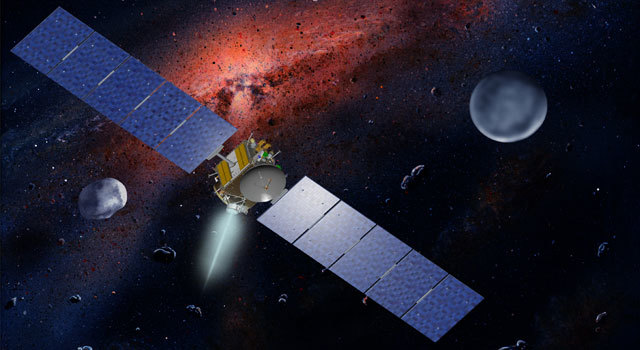News | June 20, 2011
NASA Hosts Preview of Visit to Large Asteroid

› Larger view
PASADENA, Calif. -- NASA will host a news briefing at 11 a.m. PDT (2 p.m. EDT) on Thursday,
June 23, to discuss the Dawn spacecraft's year-long visit to the large asteroid Vesta. The mission is
expected to go into orbit around Vesta on July 16 and begin gathering science data in early August.
The event will be held at NASA Headquarters in Washington and will be broadcast live on NASA Television and streamed at http://www.nasa.gov/ntv . In addition, the event will be carried live on Ustream, with a live chat available, at http://www.ustream.tv/nasajpl2 .
Local reporters are invited to watch via satellite, with two-way question-and-answer capability, at NASA’s Jet Propulsion Laboratory in Pasadena, Calif. Reporters who would like to come to JPL must RSVP to the Media Relations Office in advance at 818-354-5011. Valid media credentials are required, and non-U.S. citizens must also bring a passport.
Dawn's visit to Vesta will be the first prolonged encounter with a main belt asteroid and the first trip to a protoplanet, a large body that almost became a planet. Observations will help us understand the earliest chapter of our solar system's history.
The panelists are:
-- W. James Adams, deputy director, Planetary Science Directorate, NASA Headquarters
-- Robert Mase, Dawn project manager, NASA’s Jet Propulsion Laboratory, Pasadena, Calif.
-- Christopher Russell, Dawn principal investigator, UCLA
-- Carol Raymond, Dawn deputy principal investigator, JPL
Reporters may attend the event, ask questions from participating NASA locations or join by phone. To obtain dial-in information, journalists must e-mail Dwayne Brown at dwayne.c.brown@nasa.gov with their name, media affiliation and work telephone number by 11 a.m. on June 23.
For more information about Dawn, visit: http://www.nasa.gov/dawn . JPL is managed for NASA by the California Institute of Technology in Pasadena.
The event will be held at NASA Headquarters in Washington and will be broadcast live on NASA Television and streamed at http://www.nasa.gov/ntv . In addition, the event will be carried live on Ustream, with a live chat available, at http://www.ustream.tv/nasajpl2 .
Local reporters are invited to watch via satellite, with two-way question-and-answer capability, at NASA’s Jet Propulsion Laboratory in Pasadena, Calif. Reporters who would like to come to JPL must RSVP to the Media Relations Office in advance at 818-354-5011. Valid media credentials are required, and non-U.S. citizens must also bring a passport.
Dawn's visit to Vesta will be the first prolonged encounter with a main belt asteroid and the first trip to a protoplanet, a large body that almost became a planet. Observations will help us understand the earliest chapter of our solar system's history.
The panelists are:
-- W. James Adams, deputy director, Planetary Science Directorate, NASA Headquarters
-- Robert Mase, Dawn project manager, NASA’s Jet Propulsion Laboratory, Pasadena, Calif.
-- Christopher Russell, Dawn principal investigator, UCLA
-- Carol Raymond, Dawn deputy principal investigator, JPL
Reporters may attend the event, ask questions from participating NASA locations or join by phone. To obtain dial-in information, journalists must e-mail Dwayne Brown at dwayne.c.brown@nasa.gov with their name, media affiliation and work telephone number by 11 a.m. on June 23.
For more information about Dawn, visit: http://www.nasa.gov/dawn . JPL is managed for NASA by the California Institute of Technology in Pasadena.


